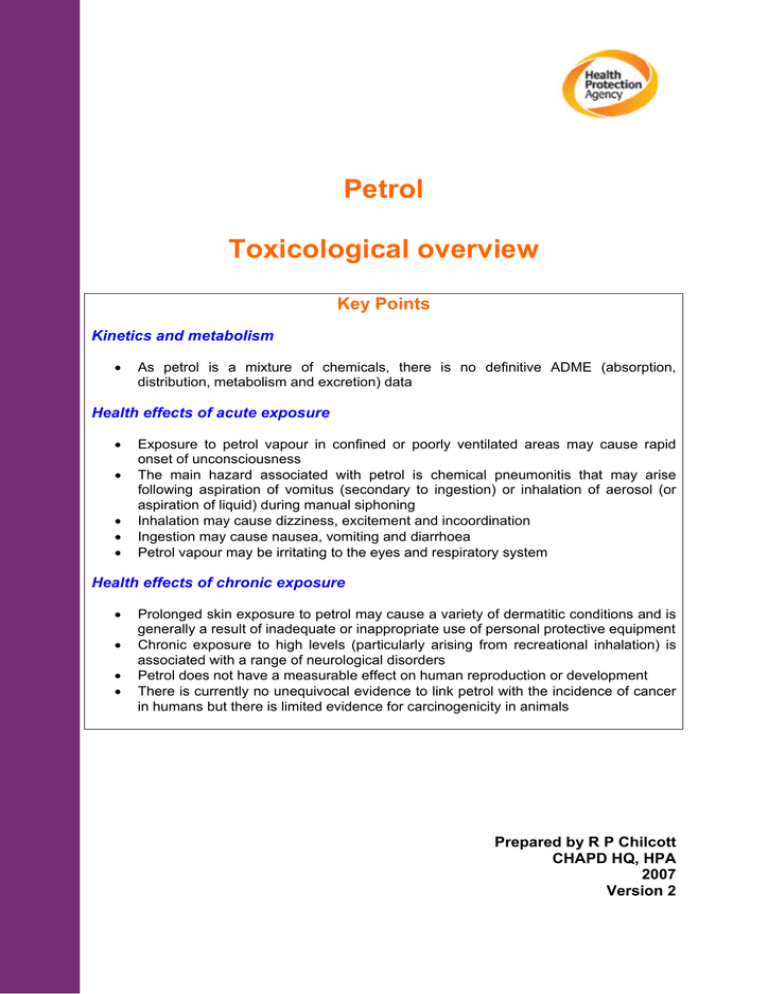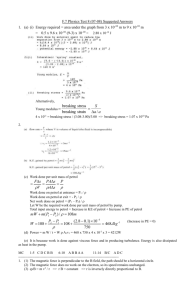Petrol Toxicological overview
advertisement

Petrol Toxicological overview Key Points Kinetics and metabolism • As petrol is a mixture of chemicals, there is no definitive ADME (absorption, distribution, metabolism and excretion) data Health effects of acute exposure • • • • • Exposure to petrol vapour in confined or poorly ventilated areas may cause rapid onset of unconsciousness The main hazard associated with petrol is chemical pneumonitis that may arise following aspiration of vomitus (secondary to ingestion) or inhalation of aerosol (or aspiration of liquid) during manual siphoning Inhalation may cause dizziness, excitement and incoordination Ingestion may cause nausea, vomiting and diarrhoea Petrol vapour may be irritating to the eyes and respiratory system Health effects of chronic exposure • • • • Prolonged skin exposure to petrol may cause a variety of dermatitic conditions and is generally a result of inadequate or inappropriate use of personal protective equipment Chronic exposure to high levels (particularly arising from recreational inhalation) is associated with a range of neurological disorders Petrol does not have a measurable effect on human reproduction or development There is currently no unequivocal evidence to link petrol with the incidence of cancer in humans but there is limited evidence for carcinogenicity in animals Prepared by R P Chilcott CHAPD HQ, HPA 2007 Version 2 PETROL– TOXICOLOGICAL OVERVIEW Toxicological Overview Petrol is a complex mixture of aliphatic and aromatic hydrocarbons derived from blending fractions of crude oil with brand-specific additives. The actual composition of petrol will vary according to the source of crude oil, the manufacturing process and between batches. A representative composition of European petrol is given at Annex I. Unless otherwise stated, this document pertains to unleaded petrol and not products of combustion or individual chemical components (e.g. benzene, toluene, xylene, butadiene, etc). Vapour concentrations are expressed as ppm and refer to total hydrocarbon present. However, it should be noted that this conventional measure of concentration introduces a source of error and should be considered at best an approximation, as the average molecular weight (on which the calculation of ppm is based) may vary according to temperature, brand or batch of technical product. Summary of Health Effects At low doses, petrol vapour is irritating to the eyes, respiratory tract and skin. Exposure to higher concentrations of vapour may produce CNS effects such as staggered gait, slurred speech and confusion. Very high concentrations may result in rapid unconsciousness and death due to respiratory failure [1]. Prolonged dermal exposure to liquid petrol or inhalation of vapour has been associated with renal dysfunction, attributed to lipid degeneration of the proximal convoluted tubules and glomeruli [2, 3], the clinical manifestations of which include haematuria, proteinuria and myoglobinuria. A late-onset autoimmune glomerulonephritus has also been described [4]. Pulmonary sequelae following inhalation of petrol vapour or secondary to pulmonary elimination of volatile hydrocarbons (following ingestion or dermal absorption) include persistent atelectasis [2] and petachial haemorrhage [1]. This may be associated with concomitant ‘hydrocarbon hepatitis’ secondary to vascular endothelial damage, possibly due to hydrocarbon-induced degeneration of fatty tissue [4-6]. The critical health effect of petrol is chemical pneumonitis, arising from aspiration of liquid petrol or inhalation of petrol-contaminated vomitus [7]. Toxicological overview: Page 2 of 16 PETROL– TOXICOLOGICAL OVERVIEW Kinetics and metabolism Petrol is a complex mixture of hydrocarbons and so there is no definitive ADME data available for animals or humans. The onset of local or systemic effects following dermal, oral and inhalation exposure indicates that these are all potential routes of entry for petrol vapour or liquid. Dermal exposure to petrol can be retrospectively identified following solvent extraction of hydrocarbons from the skin surface. However, the profile of hydrocarbons found in the systemic circulation after cutaneous exposure is markedly different to that extracted from the skin [8], indicating selective uptake and distribution of individual hydrocarbon components. There is some evidence to suggest that petrol exposure may alter hepatic enzyme activity in rats and humans [9, 10], although the clinical relevance of such observations has not been established. The predominant route of elimination for volatile components of petrol is considered to be via expired air. This assumption is based on clinical observation; there are no experimental studies to confirm this route of elimination in humans. Sources and route of exposure Petrol contains mixture of volatile hydrocarbons and so inhalation is the most common form of exposure [11]. Petrol vapour can reach supra-lethal concentrations in confined or poorly ventilated areas, although such exposures are rare [12-14]. A representative sample of petrol vapour concentrations under different exposure scenarios are summarised in Table 1. It should be noted that the chemical composition (hydrocarbon profile) of petrol vapour differs substantially from the corresponding liquid (Annex I). Petrol vapour is predominantly (>70%) composed of light (C4 & C5) hydrocarbons [15] whereas liquid petrol contains mainly (>80%) C6-12 compounds [16]. The intentional inhalation of vapour (‘sniffing’ or ‘huffing’) has been extensively documented [17-22]. Table 1: Representative vapour concentrations, expressed in parts per million (ppm) or mass of total hydrocarbons per unit volume (mg m-3) under different conditions. Vapour concentration (ppm) 25,000 5 – 320 2 – 100 1–5 174 13 4 Scenario Air above open barrel in unventilated out-house on ‘hot’ day. Air around tanker during bulk-loading. Air around petrol pump in service station. Notes Environmental conditions not reported. Ref [12] [23] Environmental conditions not reported. [24] Air within petrol service station. Temperature varied from 4.5 – 25°C. Recovered petrol components were predominantly (72%) C4 and C5 aliphatic hydrocarbons. [25] Worker at bulk loading facility. Road tanker driver. Service station worker. Average exposure values. Environmental conditions not reported. Vapour concentration reported as the sum of all detected hydrocarbon constituents. [16] Toxicological overview: Page 3 of 16 PETROL– TOXICOLOGICAL OVERVIEW PETROL– TOXICOLOGICAL OVERVIEW It is generally considered that dermal absorption of petrol does not contribute significantly to systemic signs of toxicity. Accidental ingestion of petrol by adults is often the result of siphoning petrol tanks whereas the incidence of petrol ingestion in children is relatively low [7, 12]. Toxicological overview: Page 4 of 16 PETROL– TOXICOLOGICAL OVERVIEW Health Effects of Acute / Single Exposure Human Data General toxicity The acute health risks involved in handling and using petrol are minimal, provided that the product(s) are used in accordance with appropriate health and safety practices [26]. The main health effect associated with petrol exposure is chemical pneumonitis, resulting from pulmonary aspiration of vomitus following ingestion [27]. A rare complication of petrol intoxication may be cardiac arrhythmia and ventricular fibrillation, attributed to increased myocardial sensitivity to endogenous catecholamines [28]. Vascular endothelial damage of the lung, liver, kidney and spleen has been described following severe intoxication with associated renal lipid degeneration confined mainly to the proximal tubules [1, 6]. Inhalation Petrol vapour is readily detectable by most individuals at concentrations below 1 to 2 ppm [29] (as reviewed by [7]) although prior exposure within 24 hours or chronic, occupational exposure may increase the olfactory threshold [30]. It has been suggested that the concentration of petrol vapour is the primary determinant of acute toxicity rather than duration of exposure [31]. This assumption is based on exposures of less than 30 minutes and relates to one study of three dogs dosed with different petrol products [32]. The minimum concentration of petrol vapour required to elicit a mild response (cough) is probably less than 140 ppm (Table 2), although there are no human studies which have determined the exact threshold for this effect. Following inhalation, effects on the CNS are readily apparent above 900 ppm within a few minutes, the morbidity of which resembles alcohol intoxication (dizziness, excitement, incoordination, etc.). In sufficient concentration (>10,000 ppm), petrol may act as an anaesthetic, sometimes resulting in immediate loss of consciousness [1]. Indeed, the rapidity of this effect has been implicated as a significant factor in fatal incidents [12-14, 31]. Ingestion Ingestion of petrol may cause acute, generalised signs of GI tract irritation, including nausea, vomiting, colic and diarrhoea [7]. The relatively low oral toxicity of petrol is comparable to that of other petrochemical products such as kerosene (2 – 17 g kg-1) [33] and ingestion of 7.5 g kg-1 has been reported to be the lethal dose in adult humans in the absence of pulmonary effects caused by aspiration of ingested petrol or vomitus [1]. Toxicological overview: Page 5 of 16 PETROL– TOXICOLOGICAL OVERVIEW A critical, delayed health effect associated with ingestion of petrol is chemical pneumonitis, resulting from aspiration of petrol during the swallowing process or of vomitus following emesis [34]. Table 2: Summary of the human inhalation toxicity of petrol vapour. *Refers to estimated concentrations based on post-incident measurements: See also Annex II. Case studies Human volunteer studies Study type Concentration (ppm) Duration Temperature 23 ºC 140 – 270 8h 200 0.5 h 900 8h 22 ºC 2,600 1h n/s n/s > 10,700 < 5 min ‘hot’ 8,000 – 35,000* Minutes 5,000 – 16,000* Minutes n/s Effect(s) Mild irritation (coughing, sore throat), conjunctival hyperaemia. Threshold level for eye irritation. Mild CNS effects (dizziness). Tolerable. Onset of neuromuscular effects (incoordination) Rapid onset of dizziness and ‘drunkenness’ (ataxia, confusion). Threshold level for onset of anaesthetic effects. Death occurred sometime within 45 minutes of initial exposure. Death occurred sometime within five minutes of exposure. Ref [30] [35] [30] [30] [30] [12] [31] Dermal / ocular exposure Mild ocular irritation may follow prolonged (8 h) exposure to low concentrations (140 ppm) of petrol vapour [30] or shorter (30 minute) exposure to vapours above 200 ppm [35]. More pronounced signs of ocular toxicity (lacrimation) occur above concentrations of 1000 ppm [35]. One study attributed ocular irritation to the presence of hydrocarbon component(s) present in the most volatile fraction of petrol: “The substance causing eye irritation was distilled from gasoline at extremely low temperatures and in very small amounts” [30]. Skin lesions resulting from acute exposure to liquid petrol are rare and generally result only from prolonged contact (hours) with undiluted product [5]. Thus, the extent of skin injury is primarily related to the duration of the exposure rather than concentration. Petrol “burns” resemble scalding, with an initial erythema leading to blister formation [5]. Prolonged dermal exposure (45 minutes – 12 hours) may lead to partial or full thickness burns with associated loss of epidermis and coagulation necrosis [3, 6]. Discolouration of the skin (brown / yellow / gold) has been observed and attributed to dye additives. Dermal exposure to petrol is not considered to be a major factor in systemic toxicity [1]: this is based upon the assumption that skin contamination will occur concomitantly to inhalation of petrol vapour (which is considered the predominant route of entry). However, several clinical reports have suggested that dermal exposure may substantially contribute to systemic toxicity [2, 6] and it has been recommended that debridement of contaminated skin Toxicological overview: Page 6 of 16 PETROL– TOXICOLOGICAL OVERVIEW PETROL– TOXICOLOGICAL OVERVIEW may limit continued systemic absorption in cases where prolonged dermal exposure has occurred [2]. Systemic toxicity resulting from dermal exposure has been noted with other hydrocarbon mixtures such as diesel [36]. Neurotoxicity As with other hydrocarbon solvents, petrol has anaesthetic (narcotic) properties (Table 2). Petrol also contains a number of potentially neurotoxic chemicals including n-hexane, benzene, butadiene, toluene, ethylbenzene, xylene and trimethyl pentane [37]. The approximate concentration of each constituent in liquid petrol and vapour are given in Table 3. Table 3: Average concentration of potentially neurotoxic constituents of liquid petrol and vapour [11, 38]. Numbers in brackets refer to range of values. Vapour values expressed as percentage of total hydrocarbons recovered from air samples obtained during the manual filling of cars (conditions and duration not reported). Chemical Benzene 1,3-Butadiene Ethylbenzene n-Hexane Toluene Xylene Concentration (%w/w) Liquid Vapour 2.5 (0.2 – 4.7) 1.77 (0 – 5.4) <0.1 0.65 (0 – 4.6) 2.6 (1.0 – 5.4) .009 (0 – 0.1) 2.5 (0.8 – 5) 1.37 (0 – 6.5) 11.4 (2.7 – 21.0) 1.63 (0 – 7.1) 10.6 (5.8 – 15.8) 0.48 (0 – 2.1) Historically, lead (as tetraethyl lead; TEL) has been identified as the principal component of petrol responsible for neurological deficits following intentional (recreational) inhalation or massive acute exposure. However, European legislation has prohibited the use of TEL in petrol since January 2000 [39]. Therefore, there is currently a paucity of human data pertaining to the acute neurological effects of current (unleaded) petrol products other than narcosis. Delayed effects following an acute exposure A variety of delayed, neurological deficits have historically been associated with the acute inhalation of petrol vapour, including peripheral neuritis, impairment of memory, paresthesia, ataxis and epilepsy [1]. A late-onset autoimmune glomerulonephritus has also been observed following acute exposure [4]. There is limited evidence to suggest that long-term pulmonary residual effects may occur following chemical pneumonitis (as a result of aspiration-induced pneumonitis) [27, 40], the effects of which are of unknown clinical relevance [41]. Toxicological overview: Page 7 of 16 PETROL– TOXICOLOGICAL OVERVIEW Animal and In-Vitro Data General toxicity The acute toxicity of petrol in a variety of animal species is broadly consistent with that reported in humans, being predominantly associated with CNS, pulmonary and renal effects [42]. Data on LD50 and skin and eye irritation are shown in Table 4. Table 4: Acute toxicity data for petrol [43]. Test Acute oral (LD50) Sensitisation Primary dermal irritancy Acute dermal Primary eye Species Rat Guinea pig Result 13.6 g kg-1 Not sensitising Rabbit slight Rabbit Rabbit No mortalities Non irritating Toxicological overview: Page 8 of 16 PETROL– TOXICOLOGICAL OVERVIEW Health Effects of Chronic / Repeated Exposure Human Data General toxicity Dysfunction of the central nervous system is the predominant pathological condition associated with chronic exposure to high levels and such effects arising from frequent, recreational exposure (‘sniffing’ or ‘huffing’) have been extensively documented [17-22, 4449]. There is currently insufficient evidence to unequivocally link chronic (occupational) exposure to petrol with other pathological conditions [50]. This may be because petrochemical workers are potentially exposed to a wide range of chemicals in addition to other confounding factors [42]. Historically, lead has been identified as the principal component of petrol responsible for neurotoxicity [51] and studies have demonstrated a link between lead body burden and neurological deficits as a result of petrol abuse (‘sniffing’ or ‘huffing’) [52]. However, it should be noted that the volatility of tetraethyl lead (TEL) is relatively low (0.4 mm Hg at 25ºC) and so prolonged dermal exposure associated with the practice of petrol sniffing is likely to be the predominant route of entry for TEL rather than inhalation [7]. Since 2000, petrol has only been commercially available in ‘unleaded’ form within the UK and most of Europe. This policy limits the concentration of lead in marketable petrol to less than 0.005 g L-1 as defined at Annex I of the 1998 EU Directive [39]. Whilst there is a known association between chronic petrol exposure and renal cancer in male rats [53-55], there is currently no evidence to link petrol exposure and renal cancer in humans [56, 57]. It is generally accepted that the susceptibility of male rats is mediated via a specific protein (α-2-microglobin) which is absent in other mammals [54, 58]. Genotoxicity At relatively high concentrations (1000 – 2500 ppm) in cell culture medium, petrol was mutagenic in drosophila melanogaster [59]. Negative results have been reported when petrol was investigated for its ability to induce gene mutations in bacteria (Salmonella assay) and mammalian cells using the mouse lymphoma assay [60]. Negative results were also obtained in another mammalian cell assay for gene mutation using a human lymphoblastoid cell line [61]. Negative results were reported in an in vivo bone marrow assay for clastinogenicity in the rat [60]. There is a report of positive results being obtained using the UDS (unscheduled DNA synthesis) assay: limited studies in vitro (essentially only one dose level used) gave a positive result using rat hepatocytes and marginal effect in human and mouse hepatocytes. In the same report, negative results were obtained from in vivo UDS assays in the rat, but a slight increase in UDS was observed in mice [62]. Overall, it can be concluded that petrol does not have significant mutagenic activity. Toxicological overview: Page 9 of 16 PETROL– TOXICOLOGICAL OVERVIEW Carcinogenicity Epidemiological studies have not demonstrated a statistically significant link between cancer and occupational exposure to petrol [63-71]. However, the IARC has classified petrol as “possibly carcinogenic to humans” (Group 2B) mainly on the basis that there was inadequate evidence for the carcinogenicity in humans but there was limited evidence for the carcinogenicity in experimental animals. It was also noted that certain components of petrol are known or possible human carcinogens such as benzene and 1,3-butadiene. [57]. Petrol is assigned the Risk Phrase R45 (“may cause cancer”) under the Chemical Hazard Information and Packaging for Supply (CHIPS) Regulations. Reproductive and developmental toxicity No reports specifically pertaining to the human reproductive or developmental toxicity of petrol were identified. The NOAEL for reproductive toxicity in a two-generation rat study was reported to be 20 000 mg m-3 [72]. Petrol is not classified under CHIPS (Chemical Hazards Information and Packaging Supply) regulations as a reproductive or developmental hazard. Toxicological overview: Page 10 of 16 PETROL– TOXICOLOGICAL OVERVIEW References [1] Machle, W. (1941). gasoline intoxication. Journal of the American Medical Association 117, 1965-1971. [2] Hansbrough, J. F., Zapata-Sirvent, R., Dominic, W., Sullivan, J., Boswick, J. and Wang, X. W. (1985). Hydrocarbon contact injuries. J Trauma 25, 250-2. [3] Schneider, M. S., Mani, M. M. and Masters, F. W. (1991). Gasoline-induced contact burns. J Burn Care Rehabil 12, 140-3. [4] Simpson, L. A. and Cruse, C. W. (1981). Gasoline immersion injury. Plast Reconstr Surg 67, 54-7. [5] Binns, H., Gursel, E. and Wilson, N. (1978). Gasoline contact burns. Jacep 7, 404-5. [6] Walsh, W. A., Scarpa, F. J., Brown, R. S., Ashcraft, K. W., Green, V. A., Holder, T. M. and Amoury, R. A. (1974). Gasoline immersion burn. N Engl J Med 291, 830. [7] Toxicology update. Gasoline. (1989). J Appl Toxicol 9, 203-10. [8] Hieda, Y., Tsujino, Y. and Takeshita, H. (2005). Skin analysis to determine causative agent in dermal exposure to petroleum products. J Chromatogr B Analyt Technol Biomed Life Sci 823, 53-9. [9] Harman, A. W., Frewin, D. B. and Priestly, B. G. (1981). Induction of microsomal drug metabolism in man and in the rat by exposure to petroleum. Br J Ind Med 38, 91-7. [10] Rao, G. S. and Pandya, K. P. (1980). Hepatic metabolism of heme in rats after exposure to benzene, gasoline and kerosene. Arch Toxicol 46, 313-7. [11] Cecil, R., Ellison, R. J., Larnimaa, K., Margary, S. A., Mata, J. M., Morcillo, L., Muller, J.-M., Peterson, D. R. and Short, D. (1997). exposure profile: gasoline. CONCAWE Report 97/52. [12] Aiden, R. (1958). petrol-vapour poisoning. British Medical Journal ii, 369-370. [13] Ainsworth, R. (1960). petrol-vapour poisoning. British Medical Journal 1, 1547-1548. [14] Takamiya, M., Niitsu, H., Saigusa, K., Kanetake, J. and Aoki, Y. (2003). A case of acute gasoline intoxication at the scene of washing a petrol tank. Leg Med (Tokyo) 5, 165-9. [15] Halder, C. A., Van Gorp, G. S., Hatoum, N. S. and Warne, T. M. (1986). Gasoline vapor exposures. Part II. Evaluation of the nephrotoxicity of the major C4/C5 hydrocarbon components. Am Ind Hyg Assoc J 47, 173-5. [16] Carter, M., Claydon, M., Giacopetti, D., Money, C., Pizzella, G., Margary, A. and Viinanen, R. (2002). A survey of european gasoline exposures for the period 1999 2001. CONCAWE Report 9/02. [17] Edminster, S. C. and Bayer, M. J. (1985). Recreational gasoline sniffing: acute gasoline intoxication and latent organolead poisoning. Case reports and literature review. J Emerg Med 3, 365-70. Toxicological overview: Page 11 of 16 PETROL– TOXICOLOGICAL OVERVIEW [18] Cairney, S., Maruff, P., Burns, C. and Currie, B. (2002). The neurobehavioural consequences of petrol (gasoline) sniffing. Neurosci Biobehav Rev 26, 81-9. [19] Flanagan, R. J. and Ives, R. J. (1994). Volatile substance abuse. Bull Narc 46, 49-78. [20] Fortenberry, J. D. (1985). Gasoline sniffing. Am J Med 79, 740-4. [21] Remington, G. and Hoffman, B. F. (1984). Gas sniffing as a form of substance abuse. Can J Psychiatry 29, 31-5. [22] Poklis, A. and Burkett, C. D. (1977). Gasoline sniffing: a review. Clin Toxicol 11, 3541. [23] Periago, J. F. and Prado, C. (2005). Evolution of occupational exposure to environmental levels of aromatic hydrocarbons in service stations. Ann Occup Hyg 49, 233-40. [24] McDermott, H. J. and Vos, G. A. (1979). Service station attendants' exposure to benzene and gasoline vapors. Am Ind Hyg Assoc J 40, 315-21. [25] Kearney, C. A. and Dunham, D. B. (1986). Gasoline vapor exposures at a high volume service station. Am Ind Hyg Assoc J 47, 535-9. [26] Henry, J. A. (1998). Composition and toxicity of petroleum products and their additives. Hum Exp Toxicol 17, 111-23. [27] Litovitz, T. and Greene, A. E. (1988). Health implications of petroleum distillate ingestion. Occup Med 3, 555-68. [28] Litovitz, T. (1988). Mycardial sensitization following inhalation abuse of hydrocarbons. Occup Med 3, 567-568. [29] Amoore, J., Von Burg, R. and Whittemore, I. (1983). Detectibility of Gasoline by its Odor. The Toxicologist. 22nd Annual Meeting of the Society of Toxicologists. March 6-11.. [30] Drinker, P., Yaglou, C. P. and Warren, M. F. (1943). The threshold toxicity of gasoline vapour. J Ind Hyg Toxicol 25, 225-232. [31] Wang, C. C. and Irons, G. V., Jr. (1961). Acute gasoline intoxication. Arch Environ Health 2, 714-6. [32] Haggard, H. W. (1920). the anaesthetic and convulsant effects of gasoline vapour. J Pharmacol Exp Ther 16, 401-404. [33] Chilcott, R. P. (2006). Kerosene: toxicological overview. Health Protection Agency compendium of chemical toxicity. [34] Banner, W., Jr. and Walson, P. D. (1983). Systemic toxicity following gasoline aspiration. Am J Emerg Med 1, 292-4. [35] Davis, A., Schafer, L. J. and Bell, Z. G. (1960). The effects on human volunteers of exposure to air containing gasoline vapor. Arch Environ Health 1, 548-54. [36] Barrientos, A., Ortuno, M. T., Morales, J. M., Tello, F. M. and Rodicio, J. L. (1977). Acute renal failure after use of diesel fuel as shampoo. Arch Intern Med 137, 1217. Toxicological overview: Page 12 of 16 PETROL– TOXICOLOGICAL OVERVIEW [37] Ritchie, G. D., Still, K. R., Alexander, W. K., Nordholm, A. F., Wilson, C. L., Rossi, J., 3rd and Mattie, D. R. (2001). A review of the neurotoxicity risk of selected hydrocarbon fuels. J Toxicol Environ Health B Crit Rev 4, 223-312. [38] Coker, D. T., Christian, F., Claydon, M. F., Irvine, D., Portail, C., Tindle, P., Webb, C. L. F. and Eyres, A. R. (1987). A Survery of exposures to gasoline vapour. CONCAWE Report 4/87. [39] EU (1998). Directive 98/70/EC of the European parliament and of the Council: Amendment to Coucnil Directive 93/12/EEC. Official Journal of the European Communities 350/59. [40] Eade, N. R., Taussig, L. M. and Marks, M. I. (1974). Hydrocarbon pneumonitis. Pediatrics 54, 351-7. [41] Seymour, F. K. and Henry, J. A. (2001). Assessment and management of acute poisoning by petroleum products. Hum Exp Toxicol 20, 551-62. [42] International Agency for the Research on Cancer (IARC) (1989). Occupational exposures in petroleum refining: Crude oil and major petroleum fuels. IARC Monographs on the evaluation of carcinogenic risks to humans. Volume 45. Lyon. [43] Beck, L. S., Hepler, D. I. and Hansen, K. L. (1984) The acute toxicity of selected hydrocarbons. Princeton Scientific Publishers, Inc., [44] Cairney, S., Maruff, P., Burns, C. B., Currie, J. and Currie, B. J. (2004). Neurological and cognitive impairment associated with leaded gasoline encephalopathy. Drug Alcohol Depend 73, 183-8. [45] Cairney, S., Maruff, P., Burns, C. B., Currie, J. and Currie, B. J. (2005). Neurological and cognitive recovery following abstinence from petrol sniffing. Neuropsychopharmacology 30, 1019-27. [46] Goodheart, R. S. and Dunne, J. W. (1994). Petrol sniffer's encephalopathy. A study of 25 patients. Med J Aust 160, 178-81. [47] Maruff, P., Burns, C. B., Tyler, P., Currie, B. J. and Currie, J. (1998). Neurological and cognitive abnormalities associated with chronic petrol sniffing. Brain 121 (Pt 10), 1903-17. [48] Poklis, A. (1976). Death resulting from gasoline "sniffing": a case report. J Forensic Sci Soc 16, 43-6. [49] Valpey, R., Sumi, S. M., Copass, M. K. and Goble, G. J. (1978). Acute and chronic progressive encephalopathy due to gasoline sniffing. Neurology 28, 507-10. [50] Harrington, J. M. (1987). The health experience of workers in the petroleum manufacturing and distribution industry. CONCAWE report number 2/87. [51] Kovarik, W. (2005). Ethyl-leaded gasoline: how a classic occupational disease became an international public health disaster. Int J Occup Environ Health 11, 38497. [52] Seshia, S. S., Rjani, K. R., Boeckx, R. L. and Chow, P. N. (1978). The neurological manifestations of chronic inhalation of leaded gasoline. Dev Med Child Neurol 20, 323-34. Toxicological overview: Page 13 of 16 PETROL– TOXICOLOGICAL OVERVIEW [53] Halder, C. A., Holdsworth, C. E., Cockrell, B. Y. and Piccirillo, V. J. (1985). Hydrocarbon nephropathy in male rats: identification of the nephrotoxic components of unleaded gasoline. Toxicol Ind Health 1, 67-87. [54] Olson, M. J., Garg, B. D., Murty, C. V. and Roy, A. K. (1987). Accumulation of alpha 2u-globulin in the renal proximal tubules of male rats exposed to unleaded gasoline. Toxicol Appl Pharmacol 90, 43-51. [55] Short, B. G., Burnett, V. L., Cox, M. G., Bus, J. S. and Swenberg, J. A. (1987). Sitespecific renal cytotoxicity and cell proliferation in male rats exposed to petroleum hydrocarbons. Lab Invest 57, 564-77. [56] Trump, B. F., Lipsky, M. M., Jones, T. W., Heatfield, B. M., Higginson, J., Endicott, K. and Hess, H. B. (1984) An Evaluation of the significance of experimental hydrocarbon toxicity in man. Princeton Scientific Publishers Inc., New Jersey [57] IARC (1989). Occupational Exposure in Petroleum Refining; Crude Oil and Major Petroleum Fuels. IARC Monogr Eval Carcinog Risks Hum 45. [58] Olson, M. J., Johnson, J. T. and Reidy, C. A. (1990). A comparison of male rat and human urinary proteins: implications for human resistance to hyaline droplet nephropathy. Toxicol Appl Pharmacol 102, 524-36. [59] Nylander, P. O., Olofsson, H., Rasmuson, B. and Svahlin, H. (1978). Mutagenic effects of petrol in Drosophila melanogaster I. Effects of benzene and 1,2dichloroethane. Mutat Res 57, 163-7. [60] Conaway, C. C., Schreiner, C. A. and Cragg, S. T. (1984) Mutagenicity evaluation of petroleum hydrocarbons. Princeton Scientific Publishers Inc, New Jersey [61] Richardson, K. A., Wilmer, J. L., Smith-Simpson, D. and Skopek, T. R. (1986). Assessment of the genotoxic potential of unleaded gasoline and 2,2,4trimethylpentane in human lymphoblasts in vitro. Toxicol Appl Pharmacol 82, 316-22. [62] Loury, D. J., Smith-Oliver, T., Strom, S., Jirtle, R., Michalopoulos, G. and Butterworth, B. E. (1986). Assessment of unscheduled and replicative DNA synthesis in hepatocytes treated in vivo and in vitro with unleaded gasoline or 2,2,4trimethylpentane. Toxicol Appl Pharmacol 85, 11-23. [63] Dement, J. M., Hensley, L. and Gitelman, A. (1997). Carcinogenicity of gasoline: a review of epidemiological evidence. Ann N Y Acad Sci 837, 53-76. [64] Enterline, P. E. (1993). Review of new evidence regarding the relationship of gasoline exposure to kidney cancer and leukemia. Environ Health Perspect 101 Suppl 6, 1013. [65] Enterline, P. E. and Viren, J. (1985). Epidemiologic evidence for an association between gasoline and kidney cancer. Environ Health Perspect 62, 303-12. [66] McLaughlin, J. K. (1993). Renal cell cancer and exposure to gasoline: a review. Environ Health Perspect 101 Suppl 6, 111-4. [67] McLaughlin, J. K., Blot, W. J., Mandel, J. S., Schuman, L. M., Mehl, E. S. and Fraumeni, J. F., Jr. (1983). Etiology of cancer of the renal pelvis. J Natl Cancer Inst 71, 287-91. Toxicological overview: Page 14 of 16 PETROL– TOXICOLOGICAL OVERVIEW [68] McLaughlin, J. K., Blot, W. J., Mehl, E. S., Stewart, P. A., Venable, F. S. and Fraumeni, J. F., Jr. (1985). Petroleum-related employment and renal cell cancer. J Occup Med 27, 672-4. [69] McLaughlin, J. K., Mandel, J. S., Blot, W. J., Schuman, L. M., Mehl, E. S. and Fraumeni, J. F., Jr. (1984). A population--based case--control study of renal cell carcinoma. J Natl Cancer Inst 72, 275-84. [70] Norell, S., Ahlbom, A., Olin, R., Erwald, R., Jacobson, G., Lindberg-Navier, I. and Wiechel, K. L. (1986). Occupational factors and pancreatic cancer. Br J Ind Med 43, 775-8. [71] Rushton, L. and Alderson, M. R. (1983). Epidemiological survey of oil distribution centres in Britain. Br J Ind Med 40, 330-9. [72] McKee, R. H., Dally, S., Dmytrasz, B. A., Gonnet, J. F., Hagemann, R. E., Mackerer, C. R., Nessel, C. S., Priston, R. A. and Riley, A. J. (2000). An assessment of the reproductive toxicity of gasoline vapour. CONCAWE Report number 00/53. Brussels. Toxicological overview: Page 15 of 16 PETROL– TOXICOLOGICAL OVERVIEW Annex I: Average composition of (European) petrol liquid and vapour. Aliphatic hydrocarbons 70 Aromatic hydrocarbons Percentage (w/w) 60 liquid 50 vapour 40 30 20 10 0 3 4 5 6 7 8 9 10 6 7 8 9 10 Carbon Number This document will be reviewed no later than 3 years or sooner if substantive evidence becomes available. Toxicological overview: Page 16 of 16





